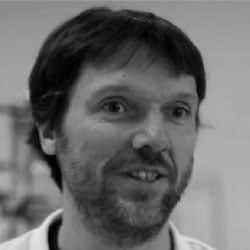
Perspectives
From the past to the future
NATURAL AND ARCHEOLOGICAL ANALOGUES
 Philippe Dillmann is research director at the CNRS and deputy director of the UMR3685 “Nanosciences and innovation for materials, biomedicine and energy” (CEA/CNRS)
Philippe Dillmann is research director at the CNRS and deputy director of the UMR3685 “Nanosciences and innovation for materials, biomedicine and energy” (CEA/CNRS)
 Stéphane Gin is research director at CEA. He works in the Department of Research on Enrichment, Decommissioning and Waste Technologies (DE2D) at CEA-Marcoule.
Stéphane Gin is research director at CEA. He works in the Department of Research on Enrichment, Decommissioning and Waste Technologies (DE2D) at CEA-Marcoule.
 Delphine Neff is a researcher at the Archaeomaterials and Alteration Prediction Laboratory
Delphine Neff is a researcher at the Archaeomaterials and Alteration Prediction Laboratory
The design of materials whose properties must be guaranteed over long time-scales, sometimes easily exceeding that of a human generation, is one of the current challenges for engineering and science. Whether for steel or reinforced concrete structures or industrial buildings (bridges, nuclear power plants), for which one wishes to prolong the lifetime, or for final disposal of nuclear waste in deep geological layers (concept based on a series of barriers of different types between the radionuclides and the biosphere) the safety of which must be guaranteed for several tens of thousands of years, the engineers are asked to design the structures and the researchers to predict the behaviour of the materials under certain stresses (mechanical, chemical, radiological) for time-frames that are inaccessible to experimentation in real conditions. One of the major aspects is the alteration of these materials by water, which will gradually affect their functional properties (mechanical strength, confinement, etc.). It is therefore crucial to be able to understand the processes at work when modelling this alteration as a function of time and the environment, over the very long time-frames envisaged.
This is a truly major challenge, drawing together all aspects of experimental science, predictive modelling and engineering. It raises an additional problem: that of validating predictions and experience feedback which, for the time-frames in question, can unfortunately only be partially carried out in the laboratory. At this stage, looking back to find possibilities of comparison, or even validation on comparable systems is today part of the overall strategy adopted at CEA, in collaboration with Andra and CNRS. This is where the observation of glass and metals produced by man hundreds or even thousands of years ago, plays a vital role.
Blocks of antique glass from an 1,800 year old shipwreck discovered near the Island of Embiez (Var) in the Mediterranean sea have undergone close examination owing to their morphological similarity with nuclear glasses and their known and stable environment, thus limiting the sources of uncertainty in the modelling. These glasses were fractured following production (in the same way as nuclear glasses), and suffered alteration for nearly 1,800 years in seawater. Their initial characterisation demonstrated that the internal cracks, which are the most numerous, in fact make only a very small contribution to the overall alteration of the glass block. Alteration experiments in the laboratory, in conditions similar to those applied to nuclear glasses, were able to determine the kinetic constants of the various mechanisms at play (diffusion and dissolution of the vitreous network) and the thermodynamic parameters (affinity, nature and stability of the secondary phases) in order to develop a geochemical model for archaeological glass alteration. The simulations reproduce the observables with considerable precision and explain the alteration state of the blocks by strong coupling between the chemical reactions and the transport of ions in the cracks. Thus the predictive capability of the model was validated on multi-century alterations and bridges were built between this system and nuclear glasses for geological disposal. Although this study is currently the most complete, other analogues are used to reinforce the robustness of the models (basaltic volcanic glasses, archaeological glasses from blast-furnaces, etc.).
The long-term corrosion of metals has been particularly closely studied for irons and steels. The common use of this material means that it has been extensively present in various environments with widely differing alteration contexts, ranging from the soil, where these objects have been abandoned, to the atmosphere and hydraulic binders when they were used as reinforcements in historical monuments. Observation of the various archaeological systems enabled an envelope curve to be defined for the corrosion rates of ferrous objects over time-frames of several centuries. Thus, for dated objects, the average corrosion rate can be deduced from the discovery context, by measuring the thickness of the corrosion products and determining the quantity of iron released into the transformed medium.
Alteration mechanisms can also be studied in a very precise environment. Glinet is an ancient steelmaking site that dates back to the 16th century. Owing to the presence of an artificial lake situated upstream of the hydraulic installations, the ferrous objects buried after the manufacturing plant was abandoned corroded in an environment constantly saturated with water and poor in oxygen. Analysis of water sampled from the areas in which the objects were buried revealed anoxic and calcium-carbonate compositions very close to the conditions of certain disposal sites being envisaged for nuclear waste. Studying the objects from this site enables reliable phenomenological models to be proposed for predicting long-term behaviour, taking account of all the phenomena involved, from the nanometric to the macroscopic scale of the object. The purpose of this approach is to determine the physical-chemical parameters controlling the corrosion kinetics. Thus, the presence of a layer a few tens of nanometres thick was detected at the interface between the metal and the sometimes millimetric corrosion products. This layer is significantly less porous than the rest of the corrosion products and protects the object from corrosion by preventing water from reaching the metal.
In this case, the observation of analogues thus enabled the prediction of the phenomenological model developed in this environment to be consolidated. Similarly, a certain number of physical-chemical parameters used in the descriptive models (porosity, diffusion coefficient, local conductivity, etc.) can be determined from the analogues and input back into the model. It is also possible to reinitiate corrosion of the artefacts, but this time in controlled laboratory conditions. This for example enables them to be isotopically marked (by replacing the agents originating the corrosion, oxygen 16, by oxygen 18 or the hydrogen in water by deuterium) in order to precisely monitor the corrosion process. Here again, CEA know-how is being used to detect the migration of these isotopes within the layer, notably by means of a nuclear microprobe. n
To find out more
Gin, S.; Neff, D.; Dillmann, P.; Verney-Caron, A. Les analogues naturels et archéologiques, outils privilégiés pour la prédiction du comportement à long terme des matériaux. In Regards croisés : quand les sciences archéologiques rencontrent l’innovation; Balasse, M., Dillmann, P., Eds.; Editions des Archives Contemporaines: Paris, 2017; pp. 73–98 ISBN 9782813002426.
 More (4 min.)
More (4 min.)

Perspectives